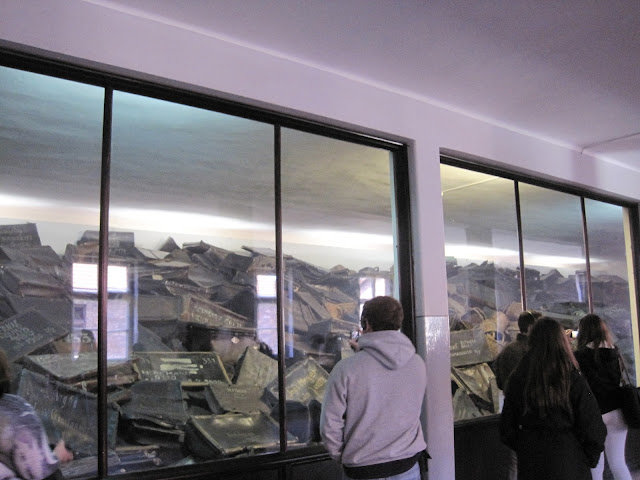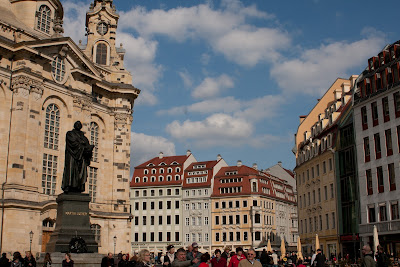18 May 2012
Auschwitz I
Auschwitz I was quite touristy which really prevented me
from being able to experience what the camp was. I found it hard to connect with the camp in an authentic
way.
Most of the buildings in Auschwitz I are original, because
they were not bombed by the Allies.
However the barracks were not built by the Nazis, and were instead part
of a previous camp that the Nazis used when they got to and started using
Auschwitz I.
You’ll notice that I keep referring to it as Auschwitz
I. That is the camp with the
“Arbeitet Macht Frei” (“work makes you free”). This sign was actually stolen a couple years ago, so now the
sign is no longer original. When the “final solution” got into full swing, they
Nazis created “Auschwitz II (Birkenau)” or Auschwitz Birkenau. This is a separate camp, very close
(just a couple kilometers) from Auschwitz I. I’ll get to that in a minute.
A few of the barracks in Auschwitz I are now used to display
artifacts from victims of the camps.
One room is full of suitcases.
You may wonder why they had suitcases if they were just being sent to
camps where they were stripped of everything and usually killed within minutes
of arrival. When the victims were
told to pack their things to move to deportation centers (like ghettos) they
were told to label their belongings clearly. This was part of the psychological trickery which was used
to maintain a relative calm and coerce the victims.
Another room is filled with the shoes of children. Another room is filled with adult
shoes, on both the left and right side.
We were walking through a room surrounded by shoes of dead mothers and
fathers who were killed for being Jewish.
The most emotional room was a room of hair. After the victims were stripped and sent
into the gas chambers (which they were told were showers), they would then
shave their heads. They were
already dead; there was no reason to shave their heads. It was done to further degrade
them. Jewish culture places a
great deal of value on hair; forcibly cutting or shaving it is complete
humiliation and degradation. There
were four tons of hair in this
room. It is being preserved there,
behind the glass (because it is contaminated with zyklon B), where it will
eventually decintigrate.
 |
| This is a bad photo because I was far away, but here's a map of the city and the two camps it contains. You see here how insanely huge Auschwitz II-Birkeneau is. |
Auschwitz II (Birkenau).
Auschwitz Birkenau was an extermination camp. I knew that it was large but I had no
idea of the true scale. Walking up to it (we walked the walk that the victims
would usually have to walk, along the train tracks and into the camp), I was
amazed and horrified at the sheer size of this place. It went on so disgustingly
far both left and right, and when I got inside, it went back just as far. Poland is an incredibly flat area (as
flat as central Florida), so when standing in the middle of the camp, you
really can’t see either end of it.
When learning about the holocaust usually you hear that most
women and children were selected to be immediately sent to gas chambers. This isn’t historically accurate. Dr. Mengele, who among other disgusting
things, was one of the primary people in charge of pointing his thumb to either
the right or left to determine prisoners’ fate upon arrival to AB. This is what largely determined the
selection process: how many prisoners they needed for slave labor that
day. If that day there was, say,
87 people needed, the strongest/healthiest 87 were spared, and most of the
others were immediately sent to the gas chambers. They would ask the young boys their age when they came
in. Many times prisoners would
pass by and tell the line of new child arrivals to lie about their age. Sometimes those kids took the advice,
sometimes they didn’t – and that alone
determined many individuals’ fate.
It’s crazy to think that how long after you arrived at the
camp was determined on so many unsure,
‘luck-driven’, coincidental, and arbitrary (in the case of Dr Mengele)
decisions.
The current estimate is that by liberation on January
27,1945, approximately 1.3 million individuals were killed in Auschwitz
II-Birkeneau. About 90 percent of
them were Jewish.
A couple last notable facts:
1. There’s an
area they informally called “Canada” in AB. It was named that by the prisoners, because they saw Canada
as a place of fortune and abundance, and this assignment was one of the
luckiest you could get in AB.
Here, the prisoners were charged with going through the clothes and
suitcases of those who were immediately killed upon arrival, to collect any
valuables, which would be turned into the SS, and then sent back to Germany on
the trains that had brought victims to the camp in the first place. Think about how valuable this job was
for these people. Every two inch
scrap of fabric was like finding gold – men could lay it on their heads in
place of the yamaka (only women got caps at camps – that was intentional [women
don’t wear head coverings in Judaism]).
Or it could be used to wipe your face of sweat – there was no water to
wash with, and people found humanity in simply pretending to wash their armpits
with their bare hands. If you had
fabric to do it with, imagine how much more real it would feel. Perhaps the most beneficial aspect of
working at Canada was finding the occasional piece of food in victims’
belongings, giving you a few calories more for that day.
2. Other measures
were taken similar to the body washing that I mentioned before, in order for
prisoners to restore some millimeter of normality and redemption back into
their lives. As prisoners, one’s
saliva production was incredibly scarce,
because of the lack of nutrients and water and the constant labor. That’s one aspect I’d never thought
about before. We heard the story
of one woman who would lick her thumb and index finger and use the tiny bit of
saliva to run down her pants in order to create somewhat of a crease in
them. To make it hold, she would
then sleep on them. It’s amazing
the things these amazing individuals thought to do to make themselves feel
human again.
It was in the barracks of Auschwitz-Birkeneau where our two survivors, Henry and Sally, shared their stories with us. They both spent time here at the camp - it's where Sally's mother and little brother were killed in gas chambers, and where Henry spent years before being one of 87 children spared by the evil Dr Mengele. But I will share their stories with you later.
Well, I’ve gone on long enough (well.. can you ever actually
go on long enough about this?), and I truly truly appreciate all of you who
made it to the end of this. It’s
respect for those 11 million who suffered in somewhat similar ways. Stay tuned for more (shorter) posts
from the rest of my trip in the coming days.
































